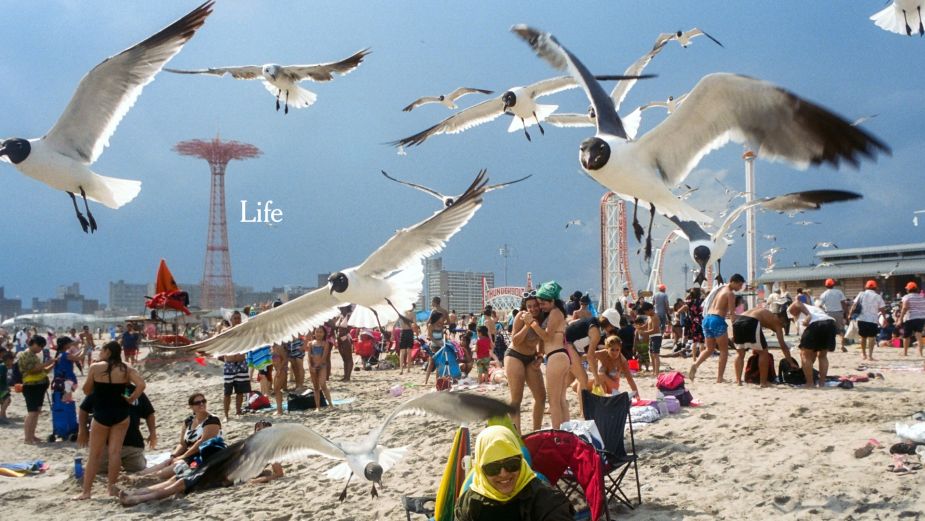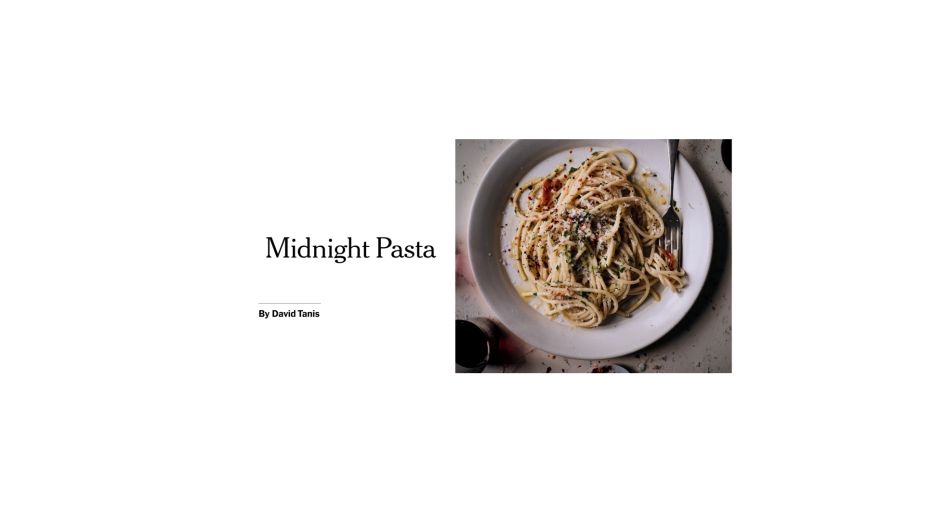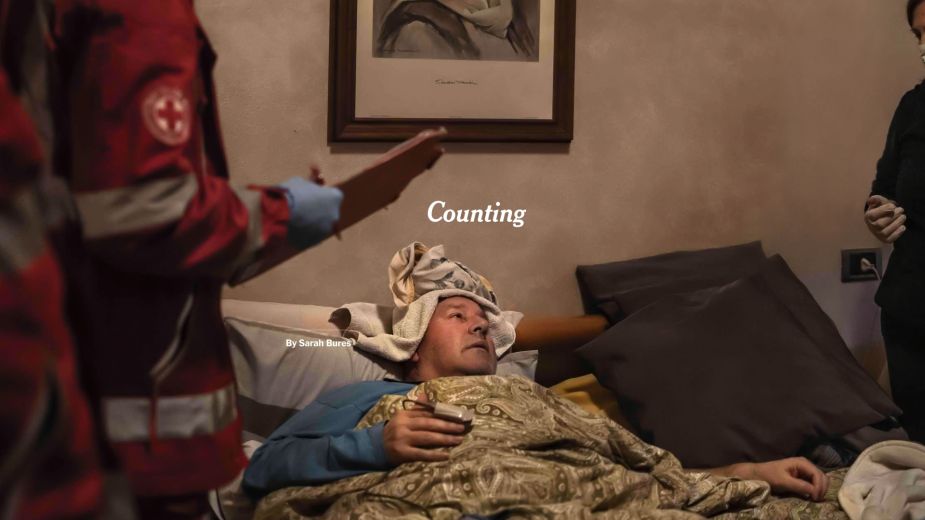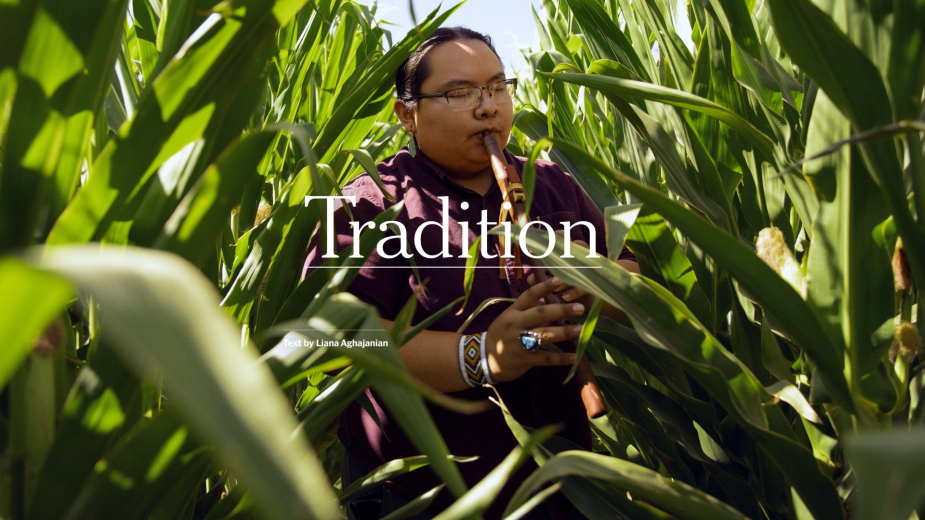
How The New York Times’ Chaotic Snapshot of 2020 Life Came to Be

The New York Times' 'The Truth Is Worth It' campaign needs little introduction. It was one of only four Immortal Awards winners in 2019. It won two Grands Prix at Cannes Lions the same year. There were two Black Pencils at the D&AD. It's a remarkable piece of work that, all awards aside, is the result of some pitch-perfect symbiosis between idea and craft. The whole campaign is just right in every way.
We were pretty excited, then, to see a new iteration of that campaign drop at the end of last week. Whereas last year's campaign used singular spots to highlight the depth and time taken to craft one particular New York Times story, the approach this year is a little different with one - quite incredible - film giving a shoutout to the overall work of the NY Times and how good journalism can guide its readers through everyday life. Dubbed 'Life Needs Truth', it's unmistakably related to its predecessor but a little more, let's say, up-to-date. It's chaotic, emotive, energetic and pretty much the perfect snapshot of life in 2020. It was brought to life by Somesuch director Kim Gehrig.
Many of you may have seen the film already, but now you can find out why and how it came to be. LBB's Addison Capper chatted with Amy Weisenbach, SVP, media and marketing strategy, The New York Times; Droga5's Toby Treyer-Evans (group creative director), Laurie Howell (group creative director), Jackie Moran (art director), Ben Brown (copywriter), and Aaron Reynolds, executive creative director at Wave Studios, who handled sound design on this film and last year's campaign.
LBB> The Truth Is Worth It campaign is so incredible and was a huge success - what were your thoughts going into this campaign with the prospect of building a new iteration for it?
Amy, NY Times> As with all of our previous brand campaign ads and all of our marketing, this new spot continues to underscore the important role of The Times's quality, original journalism in readers’ lives. And over the past few months, Times journalists have worked tirelessly to help readers and subscribers make sense of this very complex moment we’re living in. We wanted this campaign to reflect not only the breadth of coverage that The Times offers its readers but also to reflect our readers’ lives today. We wanted to make something to capture life in 2020, and we’re so pleased with the final result.
Toby, Droga5> We’re always looking to push the campaign forward and evolve the creative in a fresh way each time. We keep the core elements of The New York Times brand but make a brother, sister or cousin to the work that came before. The world has changed a lot since the last campaign so this work needed to acknowledge that - it needed to feel current, sympathetic to the moment and act as a guiding hand through this unpredictable world during these uncertain times.
Aaron, Wave> The Truth Is Worth It campaign was such an incredible success, and one I’m truly honoured and proud to have been involved with. Working with such a talented and creative team was a real highlight of my career, so when asked to work on the next installment, I was obviously very excited at the opportunity. I knew it was going to be a hard act to follow after the success of last year’s campaign, but it was something I couldn’t wait to get my teeth into and be a part of, helping to build the next chapter in The New York Times story.
LBB> What was the brief to Droga5? What were your main aims and ambitions, and why was this strategic thinking the right approach now?
Amy, NY Times> Life is always full of questions, but given the way life has been upended in 2020, this is truer now than ever before. Our newsroom has quickly adapted to answering all of our readers’ questions - across complex, massive, societal issues like the pandemic and the global reckoning with police violence and racism, but also to more mundane questions about how to adapt to daily life right now. We wanted to highlight this commitment, this relentless push to help our readers move forward in this moment. It was important for us to put our reader at the centre, to ground ourselves in the questions they’re asking, and be inspired by the reporting that is helping them through it. That was really what the brief was all about: showing people how The Times is there to help you navigate life, especially as it becomes increasingly unpredictable.
Laurie, Droga5> This year has been an unusual one, so, as you can imagine, the brief we had in our hands at the beginning of the year was very different to the one that led to this work. The new brief was all about telling the story of how The Times can help us and guide us in every part of life, in addition to the depth of the journalism The New York Times has to offer. In the past, we’ve shown everything that goes into publishing one piece of journalism, but this time, we shared what independent, quality journalism can bring to the reader, showcasing the value of Times journalism in a different way and proving how it can be an invaluable resource in the world right now.

LBB> I needn't list everything that's happened but this year has been a lot - so much has happened and so much of it newsworthy. On the one hand, you weren't short of things for inspiration here, but on the other you needed to condense all that into this two-minute film. Tell us about the research process and working out exactly what you wanted to feature in this film.
Jackie, Droga5> When you think of everything that’s happened in the world since we began this project back in March, the film has changed a lot since then. Luckily, when you’re working on The Times, you’re constantly immersed in and processing the evolving state of the world, so you develop a sense of what’s important to be talking about. As for the process, it was a back and forth between us, The Times team and the newsroom to determine the best cross section of life to put into the film because we’re all living it - we then looked to creatively develop the thread and arc of the piece, pulling you in different ways, just like life does.
LBB> The stories you've selected to use the headlines of are an eclectic mix. The one about the pronunciation of 'NoTuhDay' in The Daily made me chuckle. What was the process of getting that balance of tone just right?
Ben, Droga5> As with the story selection, getting to the right tone was this iterative process. We wanted to make sure we were representing all aspects of life to most accurately portray what it feels like to actually live during these times. Perfectly striking that balance involved a lot of conversations between The Times and us while factoring in an ever-changing world, making tiny adjustments to the script as we went along. There were versions of the script that were more playful than the final thing and some that were more sombre. Ultimately, we’re really happy with where it landed tonally.

LBB> Amy, everything within this campaign actively comes from NY Times sources - with that in mind, how involved are you in the creative and research process? Is it quite collaborative between you and Droga5?
Amy, NY Times> Every day, The New York Times produces original, quality, fact-checked journalism that helps people understand and navigate the world. Though we know this pandemic has changed how our reporters work, it hasn't changed what they do.
The process to make an ad like this required a collaborative process with Droga5. We've been working with their team since 2017, and they’ve come to deeply understand Times journalism and how to capture the breadth and depth of our reporting in a really beautiful way. We worked with them to choose the right headlines and images across the range of reporting. It was important for us to emphasise all of the lines of coverage our journalists are bringing our readers to meet this moment and help them navigate it all.
LBB> Then there's the poem that you've written to tell your narrative - can you tell us about the inspiration behind that approach and the actual process of writing the poem?
Ben, Droga5> There’s obviously a rich tradition of poetry as a means to process tumultuous times, Gil Scott-Heron was a big influence, for example. Poetry can capture the immensity of the world and put it in terms we can all understand and feel, which is also the power of journalism. The actual writing process was a bit of a puzzle. It involved scouring hundreds of articles, looking for linguistic gems, then compiling them all and refining them from there. Every single line in the final film has been rigorously questioned for the way it illustrates a facet of life, whether it rhymes, looks a certain way on the screen or works rhythmically.

LBB> I feel like there are so many parts to the creative process behind the film - which other elements were pivotal in bringing this to life on top of the research and the poem?
Jackie, Droga5> Since this was as much a visual poem as it was a written one, how the imagery and art direction bonded with the writing and music was a big part of creating one cohesive narrative arc. This meant choosing shots that reinforced each line on screen while considering what the music was doing at each point. Getting to the finished thing was a process of searching thousands of images - first trying them with the lines superimposed - and then, in the edit, gradually narrowing them down as we went. What you see in the final cut is the result of that process wherein each image, each line and each musical beat has been combined with each other in mind.
LBB> The track is amazing. It's almost really jarring and trippy and then the type over the top is really quite linear and there's this crazy juxtaposition between the two. How did you land on this track and why was it the perfect backdrop to the film?
Toby, Droga5> We always thought jazz would be a good fit for this piece because it’s able to flex to all corners of life - sometimes it's happy, sometimes reflective, sometimes sentimental. Having explored a lot of jazz, (and after some good conversations with the jazz enthusiasts at The Times), we were drawn to the free-form nature of Makaya McCraven. This particular track that we used gave the feeling of the chaos and unpredictability of life but with a steady, driving pulse, which drove the momentum and acted as the backbone throughout. Once we’d landed on the track, we worked with the music house to shape this track so it could speak to all parts of life.
LBB> Amy, I know this is a question quite focused on the creative, but I wanted to ask you about the soundtrack too. What are your thoughts on it? And what were your thoughts when it was presented to you?
Amy, NY Times> It is amazing, right? The creatives made an impassioned case that jazz was the right genre of music for this ad because it mirrors the breadth of Times coverage. Jazz has a way of reflecting the emotion of every corner of life: the highs, the lows, the happy, the sombre, and we needed to reflect a range of emotions in the work. This particular track also has a great driving backbone that gives the piece rhythm and purpose which were critical to achieving their vision for the ad.
It also helped to have a couple of music aficionados on The Times’s brand team. Our executive creative director Laura Forde and strategy director Iain Newton shared their ideas for jazz artists and tracks they thought best capture the moment we’re in. We sent them over to the creative team, and Droga found inspiration in the work. One of the artists we shared - Makaya McCraven - and his song Requests ended up being the track they selected.
LBB> And Aaron, how did the track feed into your approach for the sound?
Aaron> I remember when I first heard the track and thought, wow, how cool and funky it was. I really wanted the sound design to reflect the same cool and funky vibe. There are lots of really fun interesting moments throughout the piece where the sound design follows that fun, bombastic journey. But I was also aware that the sound design needed to help you follow the text and story unfolding in front of you on-screen. This is where the typing played a key role. It was important that it had a clear, linear voice throughout to help you follow the text and story, while at the same time complementing the music perfectly.
LBB> I know that for the previous spots you spent a LONG time nailing down the sound for the typing. Was it a similar approach here or did it require something different?
Aaron, Wave> Elements of it are similar, considering the tone and nature of The Truth Is Worth It typing, but this time we wanted it to become more musical, to become its own instrument, kind of like the vocal of the track. We spent a lot of time carefully positioning each click, making sure that it was sitting in perfect harmony with the track, which meant a lot of pitch shifting, repositioning and carefully crafted sound to maintain the seamless, symbiotic union. As you can imagine, I’m going to be dreaming about keyboard clicks for a long time to come!

LBB> Why was Kim Gehrig the right director to bring Droga5 and NY Times’ vision to life?
Laurie, Droga5> Kim’s energy and style matched where we wanted to go with this project. She has an amazing ability to capture life in an emotional and true way, and her visual and design sensibilities felt like a good match for The New York Times and a good partner throughout the process.
LBB> What were the trickiest components and how did you overcome them?
Toby, Droga5> No doubt the idea of trying to put a rhyming structure into people’s heads using just sound and music was one of the toughest components to get right. It’s something we’d never seen done before but felt this approach could reflect the relationship the reader has with The New York Times and lead to a unique film. Getting this right, with an ever-changing script, was quite a challenge. It took a lot of early prototypes and experimentation to land on something that achieved the finished product, figuring out if the words should lead the piece or the music should lead it. In the end, we liked the idea that the journalists’ words should be the lead act with the music, images and sound design all playing the support role.
Aaron, Wave> I would say the overall narrative of the sound design was the trickiest to master. The challenge was to create something unique, fresh and original whilst still maintaining the instantly recognisable soundscape that we all know and love from The Truth Is Worth It Campaign. At the forefront of my creative thought process, I was mindful of avoiding anything that felt too heavy and serious. I wanted the sound design to feel light, fun and bombastic so that flowed with the tone set by the music.
Amy, NY Times> We wanted this campaign to paint an accurate picture of day-to-day life for Times readers in 2020. Given that this is a presidential election year, we started the year assuming that most of our creative would reflect that line of coverage. When coronavirus hit, we knew we needed a different focus for the work, and that led us to this campaign idea. However, the world continued to evolve even as we got into production and that required that the script keep evolving too. We were changing headlines and images up to the week before launch because we wanted the campaign to capture the full range of stories that our reporters are covering to help readers make sense of 2020.
The trickiest part was narrowing down the reporting to feature. The Times publishes nearly 200 stories a day, so it was hard to choose which stories were best to highlight how Times journalism is helping people make sense of it all, especially when life is as complex as it is right now.













